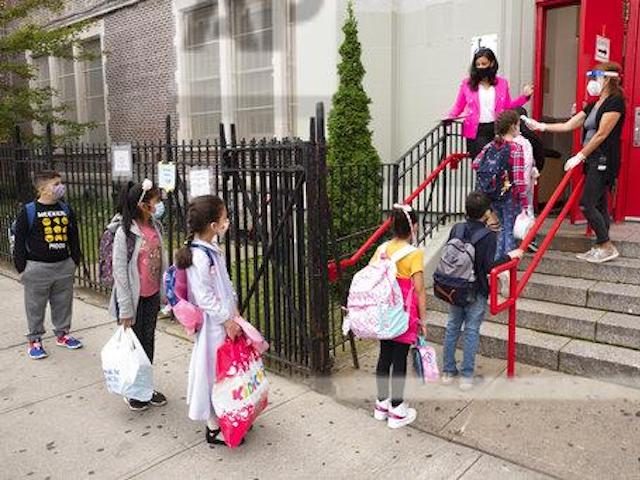The vast majority of K-12 parents support in-person learning despite looming concerns from public health officials over the Chinese coronavirus, a Gallup survey released Thursday found.
The survey, taken February 14-21 among 860 parents of school-age children, found nearly 8 in 10 support sending children back to brick and mortar schools, most of which shut down last year due to the pandemic.
Seventy-nine percent of parents of K-12 children, specifically, “support providing in-person schooling for elementary and secondary students for your community right now.”
While a majority across party lines expressed support, 94 percent of Republicans support in-person learning. Independents followed with 80 percent, and only 62 percent of Democrats agreed.
Both working and non-working parents support in-person learning, 82 percent and 71 percent, respectively. While a majority across all regions of the U.S. support schools providing in-person learning, those in the northeast expressed the strongest view, with 90 percent agreeing compared to the 72 percent in the west who said the same.
The survey also affirmed the economic impact the pandemic has had on working families. Thirteen percent reported reducing their work hours to help their children with at-home learning, and 7 percent said they either quit or took leave from their job due to schools shutting down.
The survey comes as the U.S. hits the one-year mark of World Health Organization officials formally declaring a pandemic. As a result, states across the nation effectively shut down their economies. Coupled with school closures, the pandemic shocked the economy, causing mass layoffs and hardships for millions of Americans across the country. However, as months went by, public health officials identified schools as safe places for children.
“The truth is for kids K–12, one of the safest places they can be, from our perspective, is to remain in school,” former Centers for Disease Control and Prevention (CDC) Director Robert Redfield said during a coronavirus task force meeting in November, citing data that “strongly supports that K–12, as well as institutions of higher learning, really are not where we are having our challenges.”
Redfield added reopening schools was, in essence, critical to public health.
“It would be counterproductive from my point of view, from a public health point of view, just in containing the epidemic, if there was an emotional response to say, ‘Let’s close the schools,'” he explained.
“Extensive data gathered in the last few months proved that K–12 schools could be open for in-person, face-to-face learning safely and responsibly,” Redfield added.
February 26 guidance from the CDC states it is “critical for schools to open as safely and as soon as possible, and remain open, to achieve the benefits of in-person learning and key support services”:
To enable schools to open safely and remain open, it is important to adopt and consistently implement actions to slow the spread of SARS-CoV-2 both in schools and in the community. This means that all community members, students, families, teachers, and school staff should take actions to protect themselves and others where they live, work, learn, and play. In short, success in preventing the introduction and subsequent transmission of SARS-CoV-2 in schools is connected to and facilitated by preventing transmission in the broader community.
The CDC recommends a series of mitigation strategies to reduce the spread of the virus, including masks, social distancing, hand washing, cleaning, and contact tracing, although the CDC recommends schools prioritize masks and physical distancing.
Sen. Bernie Sanders (I-VT) is among the skeptics, telling CNN the U.S. is “not going to get our kids back to school safely … unless we crush the pandemic.”
Dr. Anthony Fauci, President Biden’s chief medical advisor on the coronavirus, predicted high school students will be vaccinated in the fall, followed by elementary students in the early months of 2022.
“Just think high school kids back in the fall. Elementary school kids — when I say back, I don’t mean back in school. I mean they’re going to be back in school for sure. I mean vaccinated,” Fauci said during a virtual appearance at Tufts University Monday.
“Hopefully the level of infection will be down such that all children will be back in school within a reasonable period of time,” the National Institute of Allergy and Infectious Diseases director said. “Hopefully by the time we get to the fall term and maybe even in the spring term coming up now.”

COMMENTS
Please let us know if you're having issues with commenting.